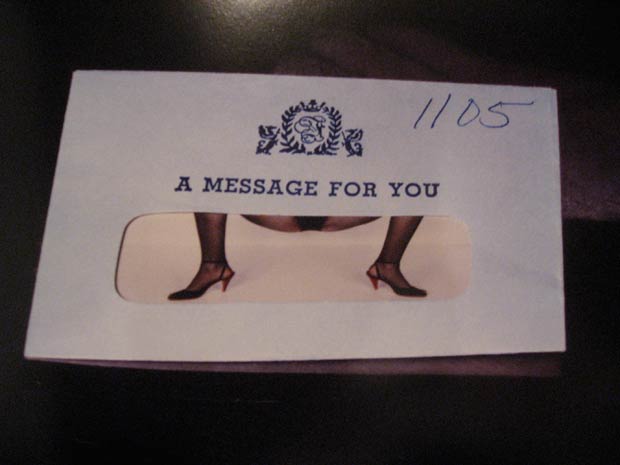ideas

Bad Sex in Fiction Awards 2009
Let’s have sex, they think simultaneously, couples having strange mind-reading powers after months and months of trying to figure each other out. (…)
She holds him tight and squeezes her body to his, sending delightful sailing boats tacking to and fro across the ocean of his back. With her fingertips she sends foam-flecked waves scurrying over his skin. (…)
Their tongues met and he felt himself dissolve, like wax melting in the heat. She stepped back slightly and removed his clothes, one by one, and then led him to the thick fur rug in front of the fire. She moaned softly as he entered her.
{ Literary Review | Continue reading | BBC | Read more }
books, sex-oriented | December 3rd, 2009 8:56 pm

Scientific advice may suggest how dangerous things are - like smoking cannabis, taking ecstasy and horse riding - but risk is not all about numbers. (…)
The tables tell us, among myriad morbid details, that through a variety of causes 23 people drowned in the bath in 2008, 108 died from “inhalation of gastric contents” and five starved to death. (…)
There is evidence that the more we try to protect some people from the risks they take, the more danger they seek.
This is known as risk homeostasis and acts like a personal thermostat, so that if someone gives you an airbag, you feel more at liberty to put your foot down. (Funnily enough, one psychological trait among the young is a tendency to overestimate the likelihood of bad things happening. They think the chance of HIV-Aids is far greater than it really is. But does that stop unprotected sex?)
There can also be confusion between the probability of a harm occurring and the severity of that harm. So if a chief scientist says nuclear power isn’t risky, he might mean it’s highly unlikely to go wrong. Someone else might think, “but if it does…”
{ BBC | Continue reading }
photo { Ryan Robinson }
health, ideas | November 25th, 2009 5:52 pm

But what do we mean by “art”?
Art is… what? A pursuit of excellence, a pursuit of meaning, a way of trying to make sense of the world. The arts, we’d say, are part of our life, our language, our way of seeing. The arts tell us truths about ourselves and each other and our society that reach parts of us that politics and journalism don’t. Art is passionate, ambiguous, complex, mysterious, and thrilling. It helps us to fit the disparate pieces of the world together; it helps us to try to make form out of chaos.
From all this I don’t imagine you’d dissent. And perhaps we could all agree on a hierarchy, a pantheon that would include, say, Shakespeare, Mozart, Bach, Beethoven, Rembrandt, Mahler, Matisse, Dickens, Beckett, Picasso, Stravinsky, Auden, Hughes, Renoir, Fellini, Orson Welles, Charlie Parker – and so on, all dead, all tested by time, all enduringly popular.
{ Richard Eyre/The Independent | Continue reading }
artwork { Roni Horn, Clown Mirror, 2001 | And more }
art, ideas | November 25th, 2009 5:52 pm

A few days ago I followed a link to Omniglot, a treasure-trove of comparative linguistics for laymen and the lovers of global alphabets, of which I am both. The page I landed on was titled Translations of Hello in many languages and featured a giant three-column table offering standard greetings in 182 languages. (…) a three-column chart? For along with “Language” and “Hello” there was the distinct-yet-apparently-essential column labelled “Hello (on phone).”
Scrutinizing column three got me thinking about how technology, language and culture intersect and interact. It’s fascinating that the telephone would require its own category of greeting—at least for 27 of the 182 languages listed. Moreover, for the vast majority of those, the word for “Hello (on phone)” is a cognate of the English hello—good news for any of us planning to answer the phone in Arabic, Armenian, Bengali, Bosnian, Bulgarian, Czech, Danish, Finnish, French, Georgian, German, Greek, Hindi, Hungarian, Indonesian, Kurdish, Lithuanian, Macedonian, Norwegian, Polish, Portuguese, Romanian, Russian, Serbian, Slovenian, Spanish, Swedish, Thai, Turkish, Ukranian, Urdu or Vietnamese. (…)
The history of hello is long and mired in many vowels. Though it didn’t show up in its current form till the mid-19th century, its forbears are many and obvious: hallo, halloo, hillo, holla (a Shakespearean favourite recently returned to slang prominence), hollo, holloa—all generally being a combination get-attention-and-greet, useful for hailing passing boats and that sort of thing.
{ Cardus | Continue reading }
photo { Helen Levitt }
Linguistics | November 25th, 2009 5:50 pm

…while politicians occasionally use poker terms when discussing strategy, more of them–and more journalists—put on their game faces with terms from chess.
You would think that people would use that terminology the way chess players use it. Most of the time, however, they’re using the terms colloquially, even though they are using them in a strategic context. While that usage isn’t wrong, it’s not as precise as it could (or should) be. (…)
In chess, a “gambit” is an opening move, one that almost always sacrifices a piece, usually a “pawn.” But its more common use, one sanctioned by most dictionaries, refers to any risky or surprising strategic move: “Senate Majority Leader Harry Reid’s gambit to include a government-run insurance option in health care legislation has given a fresh tailwind to the idea despite opposition from conservatives,” one news report said.
{ Columbia Journalism Review | Continue reading }
photo { From Russia With Love, 1963 }
Linguistics, chess | November 25th, 2009 5:42 pm

When it comes to creativity, it’s easy to imagine that more is better. Creativity lies at the heart of science. It solves problems and drives innovation. Then there’s the small matter of art and literature. Humanity’s self expression and aesthetic explorations are born of our creative drive.
And yet creativity has its downsides too, say Stefan Leijnen and Liane Gabora at the University of British Columbia in Canada. Creative solutions can only spread if they are adopted by other individuals. These imitators play an important role in society. They act as a kind of memory, storing the results of successful creative strategies for future generations. But the time that individuals spend creating means less time imitating. Clearly we cannot all be creators all the time but neither can we all be imitators.
That raises an interesting question, say Leijnen and Gabora. How much creativity does a society need to optimize the evolution of ideas?
To find out, they built a computational model that simulates the way ideas are created, how they spread and how they evolve in a society.
{ The Physics arXiv Blog | Continue reading }
photo { Guy Bourdin }
ideas, science | November 19th, 2009 6:29 pm

There are 46 days left in 2009, which means it is just about time to commence the beloved and enduring parlor game known as “Name That Decade.”
You know the rules — coin a pithy, reductive phrase that somehow encapsulates the multitude of events, trends, triumphs and calamities of the past 10 years. If you can also rope in some of the big personalities and consumer obsessions, that’s a bonus.
For the ’00s, it seems the trick will be finding a small package sturdy and flexible enough to capture so much upheaval and change. And worry — although in hindsight, it sure seems like we kept worrying about the wrong menace.
The decade began with a frenzy of fear about the Y2k millennium bug, which many technology experts said would sunder computers, crash jets and wreak havoc in every corner of the globe. As that non-emergency passed, a genuine threat quietly gathered in the form of a plot to fell the twin towers.
Later, we scoured Iraq for weapons of mass destruction, which we did not find. As we searched, we built weapons of financial chaos right here at home, with home mortgages, leverage and something called Collateralized Debt Obligations.
Fortunes and a staggering number of jobs have vanished, inflicting misery in this country and others on a scale that would surely have exceeded the most garish of Saddam’s fantasies.
So: The Era of Misplaced Anxiety?
{ NY Times | Continue reading }
time | November 19th, 2009 6:28 pm

The 400-year-old mystery of whether William Shakespeare was the author of an unattributed play about Edward III may have been solved by a computer program designed to detect plagiarism.
Sir Brian Vickers, an authority on Shakespeare at the Institute of English Studies at the University of London, believes that a comparison of phrases used in The Reign of King Edward III with Shakespeare’s early works proves conclusively that the Bard wrote the play in collaboration with Thomas Kyd, one of the most popular playwrights of his day.
The professor used software called Pl@giarism, developed by the University of Maastricht to detect cheating students, to compare language used in Edward III — published anonymously in 1596, when Shakespeare was 32 — with other plays of the period.
He discovered that playwrights often use the same patterns of speech, meaning that they have a linguistic fingerprint. The program identifies phrases of three words or more in an author’s known work and searches for them in unattributed plays. In tests where authors are known to be different, there are up to 20 matches because some phrases are in common usage. When Edward III was tested against Shakespeare’s works published before 1596 there were 200 matches.
{ Times | Continue reading }
photo { Shakespeare, The Cobbe Portrait, c. 1610 | More | The Cobbe portrait may be the only authentic image of Shakespeare made from life. }
ideas, technology | November 19th, 2009 6:28 pm

A Buddhist Koan says: “The master holds the disciple’s head underwater for a long, long time; gradually the bubbles become fewer; at the last moment, the master pulls the disciple out and revives him: when you have craved truth as you crave air, then you will know what truth is.”
The absence of the other holds my head underwater; gradually I drown, my air supply gives out: it is by this asphyxia that I reconstitute my “truth” and that I prepare what in love is Intractable.
{ Roland Barthes, A Lover’s Discourse: Fragments }
Roland Barthes died almost 30 years ago, on 26 March 1980, but his works continue to engage new and old readers with remarkable consistency.
{ London Review of Books | Continue reading }
photo { Bersa }
ideas, relationships | November 19th, 2009 6:27 pm

The pride expression is a fairly specific signal of high status. (…) The pride display may be best viewed as a gestalt signal in which the sum of various parts (expanded body posture, small smile, head tilt back, arms extended) transmits an automatically interpreted message. (…)
Pride expression sends a message that is distinct from that of happiness, consistent with a growing body of research suggesting that distinct positive emotions, such as pride and happiness, may have evolved to serve distinct functions. (…)
The high-status signal sent by pride expression also appears to be distinct from any message sent by anger. Previous research has shown that displays of anger lead observers to judge individuals as more professionally qualified than individuals displaying sadness. Thus, anger seems to convey a sense of power or competence, at least relative to a low-power (and presumably low-status) emotion such as sadness. Yet, the present findings suggest that the anger expression does not convey high status to the same extent as pride; in fact, when compared with pride, anger was relatively more associated with low status. (…)
The current results demonstrate that high-status perceptions of the pride expression are unelaborated and automatic. Indeed, this is the first research to suggest that our ability to rapidly and involuntarily assess social status may be due, in part, to our ability to automatically recognize and interpret displays of pride.
{ Azim F. Shariff and Jessica L. Tracy, Knowing Who’s Boss: Implicit Perceptions of Status From the Nonverbal Expression of Pride, 2009 | PDF | Continue reading | via OvercomingBias }
ideas, psychology, science | November 13th, 2009 9:46 am

For all its tumult — erupting stars, colliding galaxies, collapsing black holes — the cosmos is a surprisingly orderly place. Theoretical calculations have long shown that the entropy of the universe — a measure of its disorder — is but a tiny fraction of the maximum allowable amount.
A new calculation of entropy upholds that general result but suggests that the universe is messier than scientists had thought — and slightly further along on its gradual journey to death, two Australian cosmologists conclude. (…) Tthe collective entropy of all the supermassive black holes at the centers of galaxies is about 100 times higher than previously calculated. Because supermassive black holes are the largest contributor to cosmic entropy, the finding suggests that the entropy of the universe is also about 100 times larger than previous estimates.
Entropy quantifies the number of different microscopic states that a physical system can have while looking the same on a large scale. For instance, an omelet has higher entropy than an egg because there are more ways for the molecules of an omelet to rearrange themselves and still remain an omelet than for an egg, notes cosmologist Sean Carroll of the California Institute of Technology in Pasadena.
A black hole is the entropy champ because there are myriad ways for all the material that has fallen into it to be arranged microscopically while the black hole retains the same numerical values for its observable properties — charge, mass and spin.
{ ScienceNews | Continue reading }
This world is arranged as it had to be if it were to be capable of continuing with great difficulty to exist; if it were a little worse, it would be no longer capable of continuing to exist. Consequently, since a worse world could not continue to exist, it is absolutely impossible; and so this world itself is the worst of all possible worlds.
{ Schopenhauer, The World as Will and Representation, II, 46, 1818 }
artwork { Georgia O’Keeffe, Abstraction Blue, 1927 }
ideas, science, space | November 13th, 2009 9:45 am

Orchidaceae, the Orchid family, is the largest family of the flowering plants.
The Royal Botanical Gardens of Kew list 880 genera and nearly 22,000 accepted species, but the exact number is unknown (perhaps as many as 25,000) because of taxonomic disputes.
The number of orchid species equals about four times the number of mammal species, or more than twice the number of bird species. It also encompasses about 6–11% of all seed plants.
About 800 new orchid species are added each year.
{ Wikipedia | Continue reading }
Most of us have genes that make us as hardy as dandelions: able to take root and survive almost anywhere. A few of us, however, are more like the orchid: fragile and fickle, but capable of blooming spectacularly if given greenhouse care. So holds a provocative new theory of genetics, which asserts that the very genes that give us the most trouble as a species, causing behaviors that are self-destructive and antisocial, also underlie humankind’s phenomenal adaptability and evolutionary success. With a bad environment and poor parenting, orchid children can end up depressed, drug-addicted, or in jail—but with the right environment and good parenting, they can grow up to be society’s most creative, successful, and happy people.
{ The Atlantic | Continue reading }
related { Japanese researchers extract vanilla from cow dung. }
illustration { Octavio Ocampo }
Botany, food, drinks, restaurants, ideas | November 13th, 2009 9:42 am

We are apparently now in a situation where modern technology is changing the way people behave, people talk, people react, people think, and people remember. And you encounter this not only in a theoretical way, but when you meet people, when suddenly people start forgetting things, when suddenly people depend on their gadgets, and other stuff, to remember certain things. This is the beginning, it’s just an experience. But if you think about it and you think about your own behavior, you suddenly realize that something fundamental is going on. (…)
As we know, information is fed by attention, so we have not enough attention, not enough food for all this information. And, as we know — this is the old Darwinian thought, the moment when Darwin started reading Malthus — when you have a conflict between a population explosion and not enough food, then Darwinian selection starts. And Darwinian systems start to change situations. And so what interests me is that we are, because we have the Internet, now entering a phase where Darwinian structures, where Darwinian dynamics, Darwinian selection, apparently attacks ideas themselves: what to remember, what not to remember, which idea is stronger, which idea is weaker. (…)
It’s the question: what is important, what is not important, what is important to know? Is this information important? Can we still decide what is important? And it starts with this absolutely normal, everyday news. But now you encounter, at least in Europe, a lot of people who think, what in my life is important, what isn’t important, what is the information of my life. And some of them say, well, it’s in Facebook. And others say, well, it’s on my blog. And, apparently, for many people it’s very hard to say it’s somewhere in my life, in my lived life.
{ The Age of Informavore / A Talk With Frank Schirrmacher | Edge | Continue reading }
photo { Richard Kern }
ideas, technology | November 13th, 2009 9:40 am

Fictitious entries, also known as fake entries, Mountweazels, and Nihilartikels, are deliberately incorrect entries or articles in reference works such as dictionaries, encyclopedias, maps and directories. Entries in reference works normally originate from a reliable external source, but no such source exists for a fictitious entry.
The neologism Mountweazel was coined by the The New Yorker magazine based on a fictitious entry for Lillian Virginia Mountweazel in the 1975 edition of the New Columbia Encyclopedia. Another term, Nihilartikel, is of uncertain origin, combining the Latin word nihil, “nothing” with German Artikel, “article.” There is also the specific term “trap street.”
{ Wikipedia | Continue reading }
A trap street is a fictitious street included on a map, often outside the area the map covers, for the purpose of “trapping” potential copyright violators of the map, who will be unable to justify the inclusion of the “trap street” on their map.
{ Wikipedia | Continue reading }
The town of Agloe, New York was invented by map makers but eventually became a real place.
{ Wikipedia | Continue reading }
Linguistics, scams and heists | November 13th, 2009 9:39 am

{ The Year 2038 Problem: Example showing how the date would reset at 03:14:08 UTC on 19 January 2038. | Wikipedia | Continue reading }
archives, technology, time | November 13th, 2009 9:38 am

Allow me to explain “The cat is on the roof” to those of you who are unfamiliar with the joke. It goes like this: Bob goes on vacation. He asks his moron brother to take care of his cat. After a few days on vacation, Bob calls to say hi. The moron brother blurts out “Your cat is dead.”
Bob is beside himself with grief. And he chastises his moron brother for breaking the news to him in such an abrupt manner. The moron brother asks how he could have done it better.
Bob explains “Well, for example, you could have told me the cat was on the roof. The next time we talked, you could say the Fire Department is trying to get him down. The next time, you could say the cat fell during the rescue and was in the veterinarian hospital. The next time I called, you could say the cat succumbed to his injuries and passed away. That way I would be prepared for the bad news.”
The moron brother says he understands. Then he adds, “Oh, by the way. Mom is on the roof.”
{ Scott Adams | Continue reading }
illustration { Mike Giant }
Linguistics, haha | November 13th, 2009 9:37 am

Rupert Murdoch said recently that he’s planning to stop Google News from indexing his publications including the Times of London and the Wall Street Journal. Murdoch’s idea is that Google News and the like make it too easy for Internet users to sample news for free rather than paying for it as God and Rupert intended. Mark Cuban, who is very clever but with whom I rarely agree, thinks this is smart on Murdoch’s part, because Twitter is changing the way people find news, effectively disintermediating Google, but not the News Corp. publications, themselves.
It’s funny how Murdoch’s statement made Cuban think of Twitter while it made me think immediately of the A&P.
The Great Atlantic and Pacific Tea Company, or A&P, was America’s first national chain of food markets. Hell, it was America’s first self-serve market, first to have store brands, first to advertise nationally, first to have a customer loyalty program (in 1912!), first to publish its own magazine (Womens’ Day, which is still around, though no longer owned by the A&P), and for most of my childhood back in Ohio A&P was the big Kahuna of grocery chains. With $5.4 billion in sales in the mid-1960s, A&P was at least 20 percent bigger than any of its competitors.
But after 105 years of setting the pace for the grocery industry, A&P peaked in the mid-1960s and went into a decline that lasted for at least 15 years and, it can be argued, continues even to this day. A&P, which has had German owners (the Tengelman Group) since the 1970s, is more of a super-regional chain today and doesn’t particularly vie for industry leadership on any measure. What happened in the mid-1960s to hurt A&P was it opted out of being indexed by Google News.
Well not literally, but close enough. A&P management, which back in the mid-60’s was still chosen from the founding Hartford family, decided at that time to abandon shopping centers — retail aggregators as Google is a news aggregator. They reasoned that in most shopping centers the anchor store was an A&P. In their view their supermarket was the main draw for a shopping center and didn’t need any of those other shops or stores to provide traffic. The rest of the shopping center was seen by A&P management as being purely parasitic.
{ Robert Cringely | Continue reading }
related { Interview with Rupert Murdoch | video }
previously { For the next few decades, journalism will be made up of overlapping special cases. }
photox { The last days of Gourmet magazine }
economics, ideas, press, technology | November 13th, 2009 9:36 am

I personally have known a lot of really smart people and have to say they are more unconventional in their ideas, yet most of their ideas are crazy. If you have ever been to a Mensa meeting (IQ but little formal education), you realize how things like homeopathy, or truthers, get their bearings. If you have ever hung out with PhDs, you know how limited their competence scope is (at research universities they have the same IQ as Mensans, but are more disciplined and less creative). It’s no wonder guys like stereotypical MBAs, who are not so analytical but rather personable and articulate, tend to dominate society. I suspect MBA rule is less catastrophic than PhD or Mensa rule, if only because they aren’t as certain of themselves. This all gets back to the idea there is an optimal IQ, and it’s not 180, but rather, say, 125 (probably the modal IQ for any large group leader, such as Presidents and CEOs).
{ Falken Blog | Continue reading }
photo { Andrew Hetherington }
ideas | November 13th, 2009 9:35 am

‘Philosophy is the cure for which there is no adequate disease.’ –Jerry Fodor
‘The point of philosophy is to start with something so simple as not to seem worth stating and to end with something so paradoxical that no one will believe it.’ –B. Russell
‘The relation between science and philosophy is like the symbiotic relationship between the countryside and town. The former provides the latter with food receiving garbage in return.’ –L. Kolokowski
{ 3 Quarks Daily | Continue reading }
ideas | November 13th, 2009 9:32 am

How many scholarly stakes in the heart will we need before Martin Heidegger (1889-1976), still regarded by some as Germany’s greatest 20th-century philosopher, reaches his final resting place as a prolific, provincial Nazi hack? (…)
For Faye, Heidegger’s 1930s Nazi activism came from the heart. Pains takingly providing sources, Faye exhibits Heidegger’s devotion to “spreading the eros of the people for their Führer,” and the “communal destiny of a people united by blood.” We learn of Heidegger’s desire to be closer to Hitler in Munich, and his eagerness to lead the Gleichschaltung, or “bringing into line,” of the German universities with Nazi ideology. According to several witnesses, Heidegger would show up at class in a brown shirt and salute students with a “Heil Hitler!”
{ The Chronicle of Higher Education | Continue reading }
I guess I think it sounds flatly preposterous to say that Heideggerian philosophy is fascist. It’s just that the Heideggerian immune system, so to speak, is particularly bad at fighting off something like fascism. That’s not what it’s built to do. Which is a very bad thing.
{ Out of the Crook Timber | Continue reading }
Stifter in fact always reminds me of Heidegger, of that ridiculous Nazi philistine in plus-fours. Just as Stifter has totally and in the most shameless manner kitschified great literature, so Heidegger, the Black Forest philosopher Heidegger, has kitschified philosophy. (…)
I cannot visualize Heidegger other than sitting on the bench outside his Black Forest house, alongside his wife, who all her life totally dominated him and who knitted all his socks and crocheted all his caps and baked all his bread and wove all his bedlinen and who even cobbled up his sandals for him. (…) Heidegger is the petit-bourgeois of German philosophy, the man who has placed on German philosophy his kitschy nightcaps, that kitschy black night-cap which Heidegger always wore, on all occasions. Heidegger is the carpet-slipper and night-cap philosopher of the Germans, nothing else.
{ Thomas Bernhard, Old Masters: A Comedy }
photo { Heidegger’s hut has become a place of pilgrimage | full story }
flashback, ideas | November 13th, 2009 9:32 am























